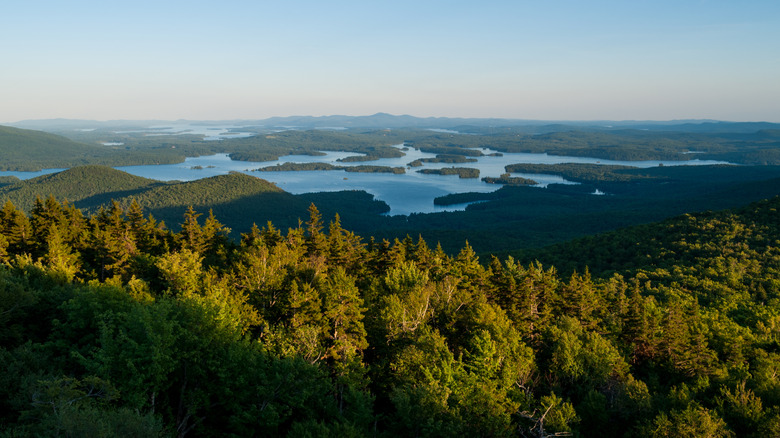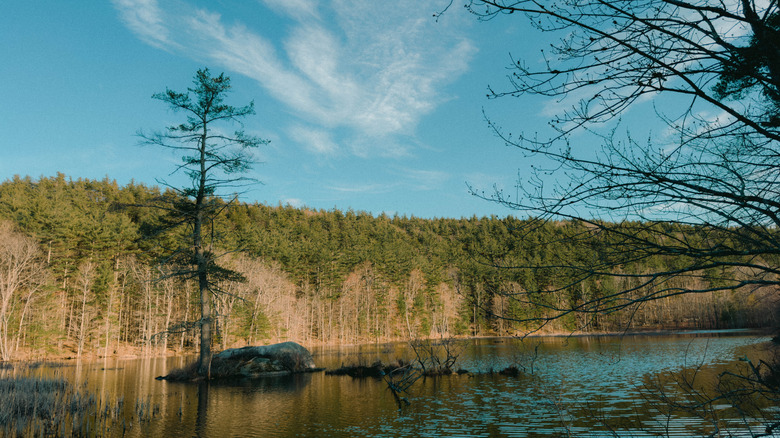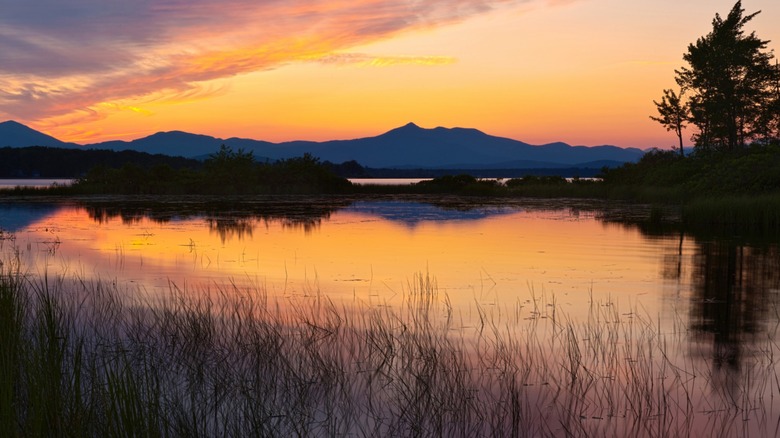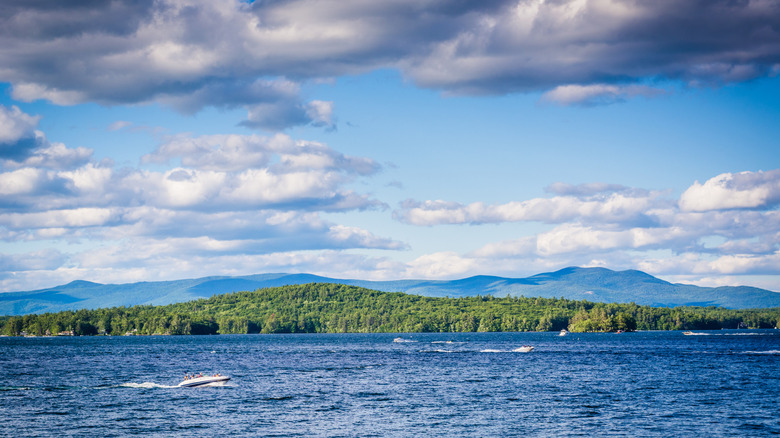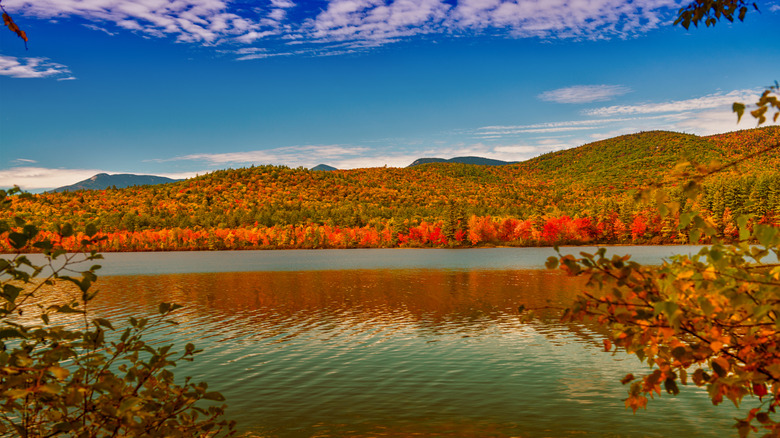These Lakes In New Hampshire Are Teeming With Snakes (Here's What You Should Know Before Swimming)
In the sweltering heat of summer, a lakeside vacation is a favorite pastime of many. Home to more than 900 lakes, with almost 300 in the picturesque Lakes Region alone, New Hampshire no doubt entices many a tourist for waterfront fun. Whether it's sunbathing on the beach, diving into the refreshing depths, or heading out on a scenic stroll, New Hampshire's glistening stretches of water offer unforgettable memories. Travelers looking to cool off should stop by Pittsburg, New Hampshire's largest town situated in the heart of beautiful lakes, rivers, and forests, or drive a few hours south to Bristol, called the gateway to Newfound Lake. But aside from attracting swimmers and boaters on holiday, New Hampshire's pristine lakes are not just the habitat of cuddly critters like river otters and beavers, but also slithering snakes — some venomous, some not.
You might think snakes only slither around dense woodlands, but some of New Hampshire's most popular, touristy lakes are a magnet for snakes to dive for food and sun themselves on shoreline rocks. Around 11 species of snakes inhabit New Hampshire's waterways, but only one of these species, the timber rattlesnake, is venomous. Other commonly spotted species are relatively harmless water snakes, brown snakes, and garter snakes, which tend to prowl the waters in search of a tasty meal. While it's a natural instinct to feel frightened upon spotting a snake while exploring, understanding their natural behaviors is important for protecting both yourself and the snake populations. Being aware of common snake colorations and patterns will also help you identify whether you're dealing with a deadly rattlesnake or a harmless brown snake. If you're planning a summer vacation in New Hampshire, here are five lakes where keeping an eye out for slithery serpents will ensure a fun (and safe) day out.
Pawtuckaway Lake
A stone's throw from Nottingham, and roughly 45 minutes by car from Concord, the state capital, Pawtuckaway Lake is a huge draw for visitors. Situated within Pawtuckaway State Park, one of the largest in New Hampshire, you'll find densely wooded shorelines where hiking the trails and refreshing swims await. A large beach area offers ample space for sunbathing, while wildlife enthusiasts can explore the vast marshlands to spot beavers, deer, and great blue herons. But this abundance of tangled underbrush also makes excellent hiding spots for snakes.
The most commonly spotted species at Pawtuckaway Lake are the northern water snake, and the deadly timber rattlesnake. A fully grown northern water snake can reach lengths of more than 4 feet, but their varying shades of brown or gray scales easily provides camouflage amidst the watery landscape. Though northern water snakes aren't venomous, their dark coloring, mottled by black or brown bands, means they are often mistaken for the venomous timber rattlesnake. To be safe, you should always give any snake you encounter here a wide berth.
The northern water snake enjoys hunting for fish and frogs in standing water, so if you're venturing down into the Pawtuckaway Lake marshes, be sure to look carefully before taking your next step. Meanwhile, a timber rattlesnake's bite packs enough venom to kill a human, so you should be especially vigilant. Anyone kayaking or boating on the water should also check the shallows are clear before launching. Bites are rare, however, and timber rattlesnakes are actually rather shy compared to other rattlesnake species. What's more, they are critically endangered, so an encounter is highly unlikely, though you should still keep a sharp eye on any densely wooded areas near the water's edge, and always listen for any rattling if you're out hiking.
Squam Lake
Stretching across the picturesque Lakes Region is Squam Lake, New Hampshire's golden pond with scenery and seclusion. Featured as the backdrop of the 1980s romantic drama, "On Golden Pond", this once-hidden gem has transformed into a hotspot for outdoor enthusiasts. Surrounded by the slopes of the White Mountains rising up in the distance, visitors can enjoy all manner of waterfront excitement, from sailing through the pristine waters to lounging on the sandy beaches. Thick woodlands and grassy swamps are popular with hikers, but make sure to be aware of the snake populations here. Species to look out for are northern water snakes, garter snakes, and brown snakes.
Sometimes reaching up to 4 feet long is the garter snake, one of New Hampshire's most commonly sighted species. Garter snakes can be distinguished by their unique pattern of three light-colored vertical stripes against a darker body, though their colors can vary drastically. While normally dark green with yellowish stripes, they have been known to range in hue from black, brown, or gray, with stripes ranging from blue, orange, or green. And while garter snakes are mostly harmless, a bite could still be unpleasant, as they produce a mild venom that can cause some swelling and bruising comparable to a bee sting.
Often found around both wetlands and woodlands, garter snakes tend to shelter beneath fallen logs and rocks, and they may strike if they feel threatened. Pay attention to where you step, especially if you're wading by the shore, preparing to launch paddle boards, or hiking the swamps and trails. Meanwhile, an appearance by the timber rattlesnake is rare, though you should always still be on the lookout. Most snakes around Squam Lake aren't a threat to humans, but it never hurts to be vigilant.
Ossipee Lake
Also in the Lakes Region, just a 40-minute drive from Squam Lake is Ossipee Lake, popular with fishermen for its abundant stock of rainbow trout, largemouth bass, and yellow perch. A public boat launch with rentals means you can spend the day out on the water, while the surrounding woodlands hide scenic hiking trails through the mountain slopes. While otters, black bears, and moose can sometimes be spotted amidst the trees, this shady habitat also attracts slithery inhabitants like the northern water snake and the eastern milk snake.
The eastern milk snake is thankfully nonvenomous, and easily distinguished from other species by its vibrant pattern. They have smooth scales in a base color of either gray or brown, mottled by large reddish blotches across the back and a checkerboard pattern on the belly. Milk snakes are drawn to a variety of habitats, from swamps and marshes to the fringes of woodlands and lakeshores, and often take cover beneath logs or stones.
Though not a danger to humans, an encounter with a milk snake might still be unpleasant for some, so always keep an eye on your surroundings. Hikers venturing through Ossipee Lake's various mountain trails should be vigilant while passing through the thick underbrush. In fact, many milk snakes are mistaken for timber rattlesnakes and thus killed out of fear, which could potentially lead to a decline in their population. Make sure to remain calm and back away slowly if you encounter a snake in your path while on a hike. If you're walking around the docks or boat launches near the shoreline, watch where you step as both water snakes and milk snakes could be sheltering there. Being alert and respectful of Ossipee Lake's local wildlife will ensure everyone a more pleasant experience.
Lake Winnipesaukee
Just southeast of Squam Lake are the glistening shores of Lake Winnipesaukee, the largest lake in New Hampshire. Tucked against the foothills of the White Mountains, the lake's dazzling, spring-fed water is a summer haven for boaters toting their fishing poles, not to mention sunbathers looking for a sandy spot to lounge. Miles of hiking trails skirt the lakeshore, meandering through dense woodlands and marshy ponds. The lake's surface is dotted with forested islands waiting to be explored, while yearly events like the Timberman Triathlon and an ice fishing derby attract regular crowds. If you're in the area, make sure to watch out for northern water snakes and eastern milk snakes.
Being cold-blooded creatures, you will likely spot the northern water snake soaking up the sun on rocks near the shoreline. Since they feed on fish, tadpoles, and amphibians, they can also be found slithering near the water in search of food. When threatened, the northern water snake tends to flatten its body and has been known to bite, harmless though it may be. If you're exploring Lake Winnipesaukee's vast hiking trails and islands, it might be prudent to carry a stick with you to prod the underbrush before walking through. Try to avoid disturbing any thick vegetation near the shoreline, and pay close attention to dark, flat rocks near the water, particularly on sunny days.
Wildlife enthusiasts might even be thrilled to chance upon a milk snake, since their vivid pattern sets them apart from their fellows. They also prefer to burrow below ground or take cover beneath rocks, so a sighting is rare. The milk snake has even been known to shake its tail in mimicry of a rattlesnake if it feels threatened. Though they are completely harmless, always remain at a distance.
Chocorua Lake
Barely a 20-minute drive north of Ossipee Lake, not far from the town of Tamworth is Chocorua Lake. The shores are blanketed with lush forests, and Mount Chocorua rises in the distance, offering fantastic views. Despite the lake's smaller size compared to other behemoths in the Lakes Region, visitors are drawn to Chocorua's quiet, untouched shores for boating and swimming, while wooded trails nearby offer thrilling hikes. Canoeing and kayaking is also popular. Separating the south end of Chocorua Lake with the smaller Little Lake is Narrows Bridge, a favorite spot for photographing the sweeping views. Visitors should be aware that they are sharing this spectacular landscape with the ever-present northern water snake, along with eastern garter snakes and brown snakes.
Brown snakes are rather petite, reaching only a maximum of 20 inches, and pose no threat to humans. Their coloration can range from light to dark brown, speckled with a uniform pattern of darker spots running the length of their body and a whitish belly. Mainly preying on earthworms and slugs, brown snakes will likely be found along Chocorua Lake's forested shorelines and brushy trails. Northern water snakes have also been known to bask on the rocks near the shallows, while eastern garter snakes will likely be sheltering in the underbrush.
Hikers heading out to Hammond Trailhead north of the lake should steer clear of any thickly wooded patches, and swimmers should check between rocks while wading along the shoreline. If you're planning to camp by the lake, find as clear a spot as possible, away from any tangled vegetation. Remember that these snakes generally prefer to avoid humans anyway, and are mostly harmless. Respecting the wildlife who share the landscape with you is the best way to enjoy an unforgettable getaway in New Hampshire's scenic lakes.
